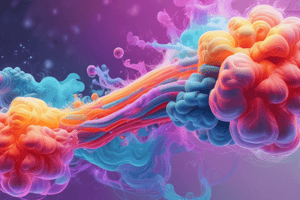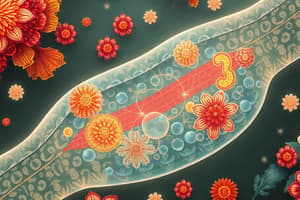Podcast
Questions and Answers
What is the main process that allows sharks to detect blood in the water?
What is the main process that allows sharks to detect blood in the water?
- Osmosis
- Diffusion (correct)
- Filtration
- Evaporation
How do insects like butterflies and moths locate flowers?
How do insects like butterflies and moths locate flowers?
- By following the scent up the concentration gradient (correct)
- By moving randomly in the area
- By detecting temperature changes
- By visual cues only
What is the correct definition of diffusion?
What is the correct definition of diffusion?
- Movement of particles from low concentration to high concentration
- Net movement of particles in a fluid down a concentration gradient (correct)
- Transfer of heat through a medium
- The mixing of different gases at equal concentration
Why is it important to understand diffusion in biological systems?
Why is it important to understand diffusion in biological systems?
What role does diffusion play in the respiratory system?
What role does diffusion play in the respiratory system?
What is the primary role of diffusion in living organisms?
What is the primary role of diffusion in living organisms?
How do substances enter and exit cells in living organisms?
How do substances enter and exit cells in living organisms?
What happens to the smell of food when it diffuses through the air?
What happens to the smell of food when it diffuses through the air?
In the digestive system, how do digested nutrients reach the blood?
In the digestive system, how do digested nutrients reach the blood?
What is a misconception about how pollinators find flowers?
What is a misconception about how pollinators find flowers?
What is an example of diffusion happening in everyday life?
What is an example of diffusion happening in everyday life?
What drives the process of diffusion?
What drives the process of diffusion?
Why is diffusion important for respiratory and circulatory systems?
Why is diffusion important for respiratory and circulatory systems?
Study Notes
Transport Systems and Diffusion
- Living organisms need transport systems to move substances like glucose, oxygen, carbon dioxide and urea.
- Substances move in and out of cells by diffusion.
- Diffusion is the net movement of particles from an area of high concentration to an area of low concentration.
Diffusion in Action
- Diffusion explains how smells travel through the air, for example, the smell of food cooking.
- Particles from the food diffuse through the air, reaching the nose and triggering the sense of smell.
Diffusion in the Digestive System
- Digested food moves from the digestive system into the blood by diffusion down a concentration gradient.
Diffusion and Pollination
- Flowers produce scents which attract pollinators like insects, birds and bats.
- These scents diffuse through the air, guiding pollinators up the concentration gradient to the flowers.
Blood and Sharks
- Sharks use diffusion to locate prey by smelling blood in the water.
- Blood diffuses through the water, creating a concentration gradient which the sharks follow.
Diffusion and the Lungs
- Diffusion is crucial for gas exchange in the lungs.
- Oxygen from the air diffuses into the blood, and carbon dioxide from the blood diffuses into the air.
Key Points
- Diffusion is the net movement of particles from an area of high concentration to an area of low concentration.
- Diffusion is essential for transport systems in living organisms, including the digestive system, pollination and the lungs.
Studying That Suits You
Use AI to generate personalized quizzes and flashcards to suit your learning preferences.
Related Documents
Description
Explore the mechanisms of diffusion and transport systems in living organisms. This quiz covers how substances move across cell membranes, the role of diffusion in digestion, and its impact on ecological interactions such as pollination. Test your understanding of these vital biological processes!






